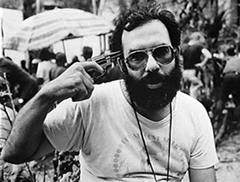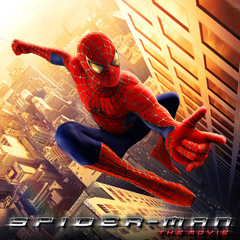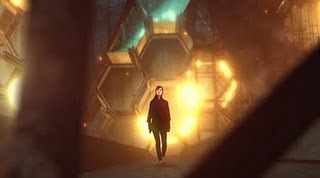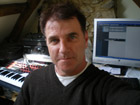Film making requires ingenuity in many different fields. One priority is matching the mood and atmosphere of your story with the right music. In this article, we speak to directors and short film makers about how to get the best music for your movie score without blowing the budget.
Part One – Big Budget vs No Budget
Music is a powerful tool in filmmaking. And choosing the right mood is an art in itself. Professional film directors work directly with composers to produce music & sound design that integrates perfectly with the imagery on the screen. They will often choose published songs to connect with the audience adding emphasis to certain scenes. But there’s a high price to pay. Top composers working with professional orchestras can ask for seven figure salaries. Perhaps more shocking is that the use of a single published work by a major artist can sometimes match or exceed that figure. Take for example the rights to use Led Zeppelin’s ‘Whole Lotta Love’ on the recent movie, ‘Lords Of Dogtown’ which cost the producers a cool $3 Million!
But typically the score for a major movie represents around 8 percent of the total budget.
With short films, this margin is greatly reduced. Often there will very little money or no budget at all. The filmmaker will need to think of all kinds of creative ideas to get the music he wants.
Stian Hafstad is a young Norwegian filmmaker. As a student he directed the much acclaimed award winning shorts, ‘Nemesis’ (2008) and ‘Liten Penis’ (2009).
“Getting the music right is everything. The right soundtrack can make or break your film. I have no idea how many hours I’ve spent in recent years listening through music samples. But it’s all worth it. The feeling you get when the music works with your scene is just amazing.”
So how does a student filmmaker go about choosing music for a scene?
“9 out of 10 times I have a clear idea beforehand what kind of music I want. I usually hear music inside my head when I read/write a script so I go out searching for something similar. However there are of course limitations, especially when you have a close to nothing budget. This doesn’t mean you can’t get good music, it just means you have to spend a lot of time searching.”
Are royalty payments and clearance issues a stumbling block for filmmakers when searching for music?
“A friend of mine recently made a documentary where there was a scene with some old people singing for about 20 seconds. She had to clear the rights for the song and pay to use it. That’s just insane. I just wish it was easier (and not expensive) to use small bands and artists. I can understand that you have to pay a lot if you want to use The Beatles, but I think many not so well know bands could benefit from letting filmmakers use their music for free.”
Can pieces of music ever offer the director ideas for storylines and edits?
“Yes! Absolutely. This happens to me all the time. I believe that some songs are just meant to be used in film. The first time you hear them you can see the outline of a scene or a montage in your head. For example. The first time I heard Coldplay’s ‘Life in Technicolor ii’, I could see the opening scene of a movie. But you could never get the clearance to use it.”
How did you go about choosing music for your film, ‘Nemesis’?
“In this film I decided to go with a well known classical work by Saint Saens for the opening scene (Aquarium from Carnival of the Animals). I love this song because it instantly creates a mood and takes you somewhere exiting. So we decided to have just a few seconds of the song before the image started, hoping to send the viewer to magical place before he saw the films first image. Also I love to play with expectations, and it was fun to play some really exciting music, and then cut to an ordinary man on a bus.”
What other advice can you offer about choosing music for short films?
“Don’t use a song just because you think it’s cool. Cool track + good scene does not always make a good film. Also, remember your first impression of a song. The music I like the most now is the music I had to work on liking. Music that I listened to over and over before it clicked. But if I use a song like this in a film people who hear it for the first time won’t necessarily feel the same way.”
Part Two – Money To Burn
To give things a little perspective, let’s look at the methods used by some of the great auteurs of filmmaking.
Francis Ford Coppola commissioned a variety of artists (including his Father) to compose & record entire scores for his 1979 epic, ‘Apocalypse Now’. Only in post production did he decide what was to be used for each scene from the hours and hours of recorded music.
 |
| Coppola: Finding the right music can be a headache |
Despite taking place in WWII, Quentin Tarrentino’s latest film, ‘Inglorious’ features music from a variety of unexpected eras. Spaghetti Western soundtracks, psychedelic funk, heavy metal and even ‘Cat People’ by David Bowie.
Speaking of which, Bowie recorded an entire soundtrack for the movie ‘The Man Who Fell To Earth’ which was rejected by director Nicolas Roeg in favour of old standards and a score by John Phillips. (Bowie’s score was subsequently never released).
Despite huge budgets, even these high end directors occasionally fall foul to the crippling cost of using published music.
Scorsese’s ‘Casino’ soundtrack album excludes many of the seminal tracks from the film due to clearance difficulties. And, although a pivotal track in David Lynch’s ‘Lost Highway’, This Mortal Coil’s ‘Song to The Siren’ does not appear on the soundtrack album.
But these are high end Hollywood directors with money to burn. Sam Raimi, for instance, put aside a pot of $4.5 million as the music budget for ‘Spiderman’. This including a brand-new song recorded exclusively for the movie by Chad Kroeger.
 |
| Spiderman: multi million dollar music budget |
Although these directors are in a different league to short filmmakers, their methods and ideas can be highly inspirational. Our student director, Stian Hafstad has some personal favourite movie scores that have inspired his own work. “Gershwin in the opening of Allen’s ‘Manhattan’, Yann Tiersens work on Jeunet’s ‘Amelie’, Gary Jules’ piano version of ‘Mad World’ at the end of ‘Donnie Darko’. I could go on and on. There are just so many!”
Sure, you may not be able to afford the same luxuries on your own short film. But at least you can enjoy mimicking some of the techniques of these great directors when it comes to including music.
For instance, something common to all directors is diegetic music, That is, music that comes from an obvious source like a radio or television. Or a quartet playing in a café. Or a busker in a street scene. Or an entire orchestra in a concert hall. It’s a great way to intertwine the music and visual action when the two are in some way meshed together on screen. But who’s to say the music playing on the radio isn’t a soundalike royalty free track? Or that the quartet is merely miming to out of copyright royalty free classical recording? Or that the busker isn’t just improvising or jamming along with the action?
For an open minded director, there are always ways and means to navigate the minefield of music usage and come up with fresh ideas.
Part Three – In Production
Iain McGuiness is the Creative Director of TV and video Production Company, AND / OR Productions.
“Most film-makers who are just starting out, and small independent production companies, like my own, don’t have the sort of money that broadcasters such as the BBC and Channel 4 can spend on their blanket agreements, for published music, and original compositions. And for young filmmakers, the processes involved in using published music are far too complicated. I found it all very overwhelming and, dare I say, not very end user-friendly.”
“For that reason, I’m a great fan of royalty-free music, and would recommend it to any film-maker. My production company has several stock music libraries, which editors can browse in order to find compositions to use in their work. We also frequent several websites to search for individual stuff that we like, including our favourite, Shockwave-Sound.com!”
We’re currently in post-production on a documentary called South Ifrica. It’s an 84-minute, three-part documentary mini-series about a charitable trip I made to South Africa around eighteen months ago. It has been made for the Community Channel, on Freeview, Sky and Virgin TV here in the UK. I chose a track from Shockwave-Sound.com for this piece, as I have with some of my other documentaries. They have a fantastic range of composers with lots of very diverse styles. So the piece I chose worked out really nicely on the finished film.”
“When choosing music, you have to think very carefully about whether the track that you want to use, actually works well with your video. Although this is largely a subjective process, it’s wise to ask friends, family and colleagues for feedback. Most of the time, you will need to experiment, in order to see which piece best achieves your artistic vision.”
“My advise would be, don’t be afraid of being original. You don’t necessarily need to use the track that countless others have used in their videos. I call this the corporate video syndrome, where one track is being widely used for countless, vastly different companies. Of course, if a track is really good, it’ll be in high demand. But that can sometimes drive myself and other filmmakers to try and find a hidden gems elsewhere.”
Part Four – The Machine Stops
Adam & Nathan Freise (The Freise Brothers) co-directed the highly acclaimed Sci-Fi short film, ‘The Machine Stops’ in which music plays an essential part in building the mood.
“Since ‘The Machine Stops’ is such a short piece, finding the right music was crucial in providing a sort of background to the story. We knew that there were many elements of the original story that we simply didn’t have time to build up and that the success of the overall mood and emotional moments would rely heavily on the ability of the music to create a sense of time and history to this underground world.”
 |
| The Machine (and the buck) Stops here |
What musical choices did you make for ‘The Machine Stops’?
“It’s important to be open to different styles, sometimes you can say a lot with irony or contrast in music, which may mean choosing something that is the opposite of the mood you initially had in mind. I often use a temp track, a piece of music I’m already familiar with that fits the tone I have in mind. Then I search to move past the temp track, looking for ways to make it more custom for the scene, fit the pace, editing style etc. There is always the danger of becoming too attached to the temp track…but it seems to have worked well for Kubrick when he used The Blue Danube as a temp track in 2001!”
Do you ever consider using free stock music or buy out tracks provided by your film school?
“Anything readily available to students for free – including music & sound effects tends to become quickly overused. You don’t want to commit on a piece that works really well with your film & find out 2 days before you’re done that a fellow student is using the same piece!”
What about using well known songs or published music in your films?
“We tend to avoid published music for the sake of originality. A film utilizing a well known track, not always, but can tend to feel gimmicky or cheap.”
How do you rate the quality of online royalty free outlets for usable music?
“I like to be optimistic and think that the online libraries are getting better in terms of how they market their composers/music. I’ve been fortunate to actually meet some great composers through online libraries. If I really like a piece I’ll contact that composer directly and see if they’re willing to tweak or further customize their piece to my film. I’ve had pretty good luck with that and am grateful to those composers.”
What advice would you offer young filmmakers about scoring their short films?
“I think the most important thing is to start thinking about it from the very beginning of the process. It’s always obvious when the music/score to a piece is an afterthought. If you’re thinking about how sound is going to be integrated within your piece from the start, it’s only going to make the piece stronger.”
How about film scores that have influenced you as directors?
“I’ve always thought the score to ‘Blade Runner’ was near perfect. The music not only complements the story but actually seems to progress it along. That combination of rich natural instruments with the plastic synth sounds is a dynamic contrast that reflects the human/android theme of the film. Another soundtrack that has left an impression on me is Jim Jarmusch’s ‘Dead Man’. Neil Young’s scratching, whining guitar creates such a haunting atmosphere for that film.”
Part Five – Infinity And Beyond
So what does the future hold for young filmmaker Stian Hafstad?
“I’ve just made an short info film for my University where I they gave me a lot of freedom to do what I wanted (within reason of course) so that was pretty fun. It has dinosaurs, a man eating flames, murder and lots of other fun stuff!”
Meantime, The Freise Brothers are currently storyboarding new ideas that they hope to get funding for.
“We are also refining the script of ‘The Machine Stops’ as a feature length version.”
And for Iain McGuiness’s AND/OR Productions?
“I’m currently in the very late stages of production for a mini-documentary about the urban sports, parkour and free-running, entitled Off The Wall, which I hope to soon turn into a full-length documentary. The film is basically about a group of young guys, here in Glasgow, Scotland, who practise parkour and free-running as their hobby. Actually, I’d say it’s more of a lifestyle for them. Of course, not everybody is happy with them back-flipping down the city streets, climbing up lamp-posts, and jumping between rooftops, and so the film also explores the conflicts between them and the authorities!”
So short filmmaking can lead to all sorts of diverse projects and careers. And as a genre, they have taken on a whole new lease of life over recent years. Directors are turning out highly sophisticated work and high quality music is seen more and more as an integral part of the process.
But as many restrictions are imposed on music usage in feature length films, the most important thing is to enjoy the freedom that making short film presentations can offer.
And then who knows, with many of the major films starting out as low budget shorts, there’s every chance that your movie could become a full length feature one day. Or even an academy award winning blockbuster. Well it could happen… Couldn’t it?
Watch the Freise Brothers work on their website.
Stian Hafstad’s short films can be viewed on www.youtube.com/user/stianhafstad
And you can watch his latest infomercial on the University’s YouTube page.
Iain McGuiness can be found at www.andorproductions.co.uk/
Or on YouTube at www.youtube.com/iainmcguinness
Simon Power (AKA Elliot Simons) produces music, sound design, IPTV programming, Podcasts, virals and other web stuff at www.meonsound.com
Shockwave-Sound.com offers original and dynamic music in a wide spectrum of genres. As much of the music here has been produced by experienced film composers it’s a great place to start searching for royalty free music.
over 50 short films and documentaries for the music technology website Sonic
State. He has also removed & replaced copyrighted music on a number
of commercial BBC releases. In these articles he offers advice and tips
about using music in your low budget film and audio/visual projects. You
can learn more about Simon and his projects at his website, http://www.meonsound.com/





